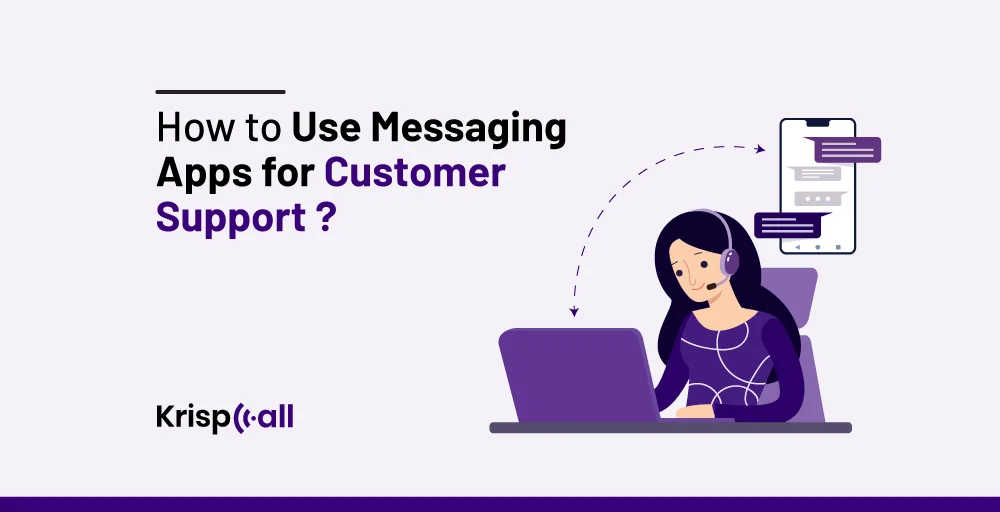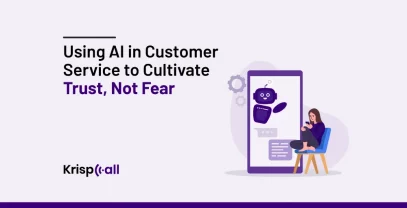Billions of users use messaging apps and social media 📱 for daily communications. Businesses are also rapidly adopting messaging apps for customer support. But why is this happening?🤔
Messaging apps like Messenger, Viber, WhatsApp, and Telegram have become part of everyone’s daily routine 💻. With a wide audience, they are undoubtedly the best place for businesses to communicate with existing and new customers. This is one reason for the increase in the use of messaging apps to provide customer service.
Having said that, you may ask a question 💭. How to use messaging apps for customer support? 🤷
In this blog📝, we have covered the 8 best ways to use messaging apps for customer support, including the 4 tips for providing successful customer support.
Let’s get started 🚀
🔐 KEY HIGHLIGHTS:
- Messaging apps for customer support refer to using apps like Messenger, WhatsApp, and Viber to initiate conversations with customers, answer their inquiries, and solve problems.
- Messaging apps provide a convenient way to maintain interactions between businesses and customers.
- The best ways to use messaging apps are: Identify customer preferences, provide quick responses, craft conversations, use automation, apply an omnichannel approach, measure performance, and integrate with CRM platforms.
- Tips for successful customer support via messaging apps are being convenient, using multimedia, deploying chatbots, and providing training to agents.
What are Messaging Apps for Customer Support?
Messaging apps for customer support are apps for delivering customer support and service. These include Facebook Messenger, Viber, Telegram, WhatsApp, etc. These apps can receive data types through Short Message Service (SMS) or Multimedia Messaging Service (MMS), which allows customers to reach out to companies and organizations to get support and solutions more conveniently.

Imagine buying a product from an online store and being able to check your order status instantly via WhatsApp Business. If there’s an issue, you can effortlessly report it, request a replacement, or even ask for a refund—all through a simple chat. This real-time interaction resolves your concerns quickly and enhances your overall customer experience.
These messaging apps allow customers to directly communicate with the company through their preferred messaging apps about their questions and inquiries and resolve them in real-time. Businesses benefit, too, as this approach helps them improve customer satisfaction using customer engagement platforms.
8 Best Ways to Use Messaging Apps for Customer Support
Messaging apps for customer support have become the most convenient and easiest way for customers to connect with service providers. This is a key reason why businesses are increasingly adopting these apps to enhance their customer service.
Here are the 8 best ways to use messaging apps for customer support:
1. Be Where Your Customers Are
You may be putting enormous effort into Facebook Messenger, but what if the majority of your audience prefers to use WhatsApp?
This is why you need to identify your audience’s preferred channel. This eases the approach and enables you to engage with a wide audience. Also, consider providing an omnichannel customer experience that ensures every customer can contact the business from any apps or channels they are comfortable with.
2. Speed is Key, But Quality Matters More
No customer wants to wait long for a reply, so speed is crucial for a great customer experience. However, fast responses aren’t enough; they must also be concise and clear. Not all customers have time for lengthy conversations.
Hence, try to make the message as short and precise as possible. Also, use multiple resources to provide thorough answers. For instance, if a customer asks about a product, share a brief list of specifications and a link to detailed information. This ensures customers get the information they need quickly and efficiently, enhancing their overall experience
3. Craft Conversations, Not Just Responses
People often spend time on social media and messaging apps, and they are tired of advertisement messages from different businesses. So, keep in mind that you will need to add a personalized touch when you start crafting conversations.
If your conversation does not differ from another advertisement, the customer will most likely leave the conversation. You’ll need to communicate and maintain proper conversational flair to sound more like a friend than a company.
Also, prioritize listening to customers’ queries and providing them with effective assistance. This will optimize customer journey for your business’s using messaging platforms.
4. Embrace Automation
Use workflow automation when required and needed because AI and automation have changed the workflow and made business easier for customer support. Chatbots are the key here for maintaining digital customer engagement and improving customer service. These AI-powered systems understand customer messages and deliver relevant automated replies, improving overall service.
Most messaging apps allow businesses to set up auto-reply automation for greetings, specifications, status updates, and more. However, not all automated replies can solve every issue, so it’s crucial to ensure responses are fast and high-quality.
5. Streamline for Efficiency
To enhance customer support, you should also consider using pre-built responses for quick, effective replies that capture customer attention and engagement. This makes support more efficient.
Integrate as many tools as possible to streamline process for the entire support process. Utilize customer analysis, knowledge base integration, and collaboration with other messaging platforms to achieve customer success.
For example, if a customer asks, “How do I create an account in [business name]?” With knowledge base integration in your messaging platform (e.g., Viber, WhatsApp, Facebook Messenger), you can automatically display the pre-set steps for creating an account. This helps you provide immediate and accurate assistance through automation.
6. Integration with CRM platforms
Integrating CRM platforms with customer messaging apps is crucial for gaining deeper insights into customer behavior and relationships. This integration facilitates personalized messaging and maintains a consistent conversation style.
By connecting CRM data with messaging apps, agents can access valuable information such as customer names, purchase history, and past interactions. And with a comprehensive overview of each customer, agents can handle interactions in a more conversational manner. This integration not only enhances customer satisfaction but also strengthens relationships by ensuring interactions are informed and personalized.
7. Omnichannel Communication
For better customer satisfaction, you need to focus on every digital channel possible to reach a larger audience and satisfy your customer preferences. Use every social media and messaging app, such as Facebook, Instagram, Snapchat, Slack, Messages Viber, etc., that provides multiple ways to communicate, including live chat, video calling, and voice calls.
These omnichannel approaches let your customer be more free and comfortable while reporting any issues related to the product or service. Using messaging apps to send a message to any business is easier and faster than calling the business number and getting annoyed if the call goes unreceived.
With this, your businesses now have more customer interactions and feedback, which allows you to improve the room for improvement.
8. Measure and Improve Continuously
Customer support through messaging apps can transform your customer experience. To measure the changes and improve accordingly, use customer experience tracking key metrics such as Net promoter score, Customer churn, Customer effort score, and customer retention rate.
With these customer service metrics, you will have proper data on your business performance toward customers, and you can start making changes in conversation styles in messaging apps. Additionally, asking for customer feedback at the last of the conversations is important.
Tips for Successful Customer Support Via Messaging App
While providing customer support via a messaging app, it is important to do it better. You will need to use more multimedia and be convenient with customers in order to provide customer support through messaging apps successfully.
Here are the 4 tips for successful customer support via messaging app:
- Be convenient toward customers: The more conveniently you interact with your customers, the more likely they will be satisfied. Try not to sound like a business while interacting from messaging apps but as a friend who’s trying to assist.
- Use multiple messaging apps: Instead of relying on one social media platform, consider using as many as possible. This creates a wider path for a wider reach.
- Deploy chatbots for 24/7 assistance: Chatbots are useful tools that provide timely responses 24/7 and solve customer queries. You can use them to assist faster to the customer faster and reduce workload.
- Provide agent training: Business messaging is more annoying than casual messaging, so consider training agents to improve communication skills. Invest more in agent training because conversations through messaging apps directly affect sales conversions.
Conclusion
With millions of people online daily, embracing messaging apps for customer support is essential. They offer businesses a direct and convenient channel to engage with customers promptly and effectively.
Moreover, these apps allow customers to send reports, feedback, or queries to businesses as if they were texting with their friends on WhatsApp, Messenger, Snapchat, etc., which familiarizes them with the different ways of business messaging.
Hence, if you want to provide efficient customer support, consider messaging apps as your weapon. By embracing this technology, you’re not just leading the way in customer satisfaction and support, but also staying ahead of the competition.
FAQ
How do I start using messaging apps for customer support?
Here are the steps for using messaging apps for customer support:
Step 1: Choose the right messaging apps and create an official account.
Step 2: Publicly display your account details to reach wide customers.
Step 3: Set up the customer support team and assign roles.
Step 4: Use CRM integrations for more convenience.
Step 5: Use chatbots and automatons for quick responses.
Step 6: Provide omnichannel support and continuously measure the performance.
Which messaging app is best for my business?
WhatsApp can be one of the best messaging apps for your business because it provides multiple communication features, including personal messages, group chats, voice and video chats, device linking, and multiple language options.




![Customer Service Goals-[How To Set Your Own]](https://krispcall.com/blog/wp-content/uploads/2024/06/Customer-Service-Goals-How-To-Set-Your-Own-407x208.webp)
